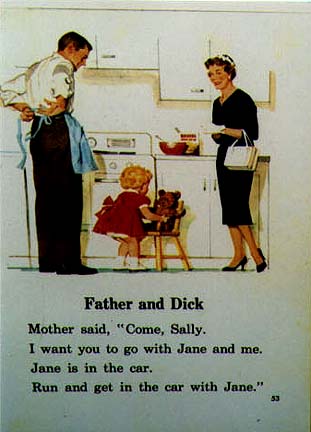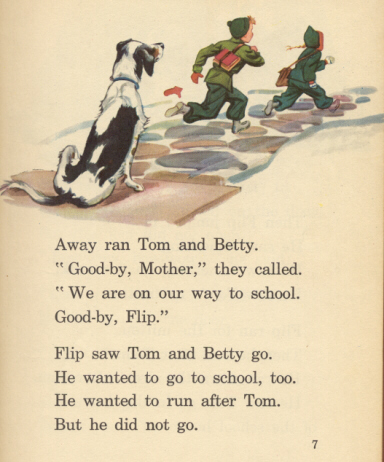Student illiteracy? Could the source be the theories and practices of American education as they have luxuriated for the past 60 odd years.
John Dewey took much of the blame for the deterioration of educational rigor, the emphasis on adjustment rather than achievement, the supplanting of competition by conformity, and the substitution of discussion for study. Actually, Dewey never denigrated the disciplines of the mind. It was his apostles and exegetes, proliferating in the mushroom cellars of Columbia’s Teachers College and thence disseminating the spores of pedagogic theories across the land, who diverted the course of education away from the pursuit of knowledge and toward the cloudy goal of “preparation for life.”

—The Dick and Jane books were the brainchild of Zerna Sharp at Scott, Foreman who edited this “look-say” reader series call pre primers. There were different writers over the years. The books used simple words (look, see, go, run) and they were repeated many times. There was a formula. “See Dick. See Dick run.” one first page read, with an accompanying illustration of Dick running. The next page said “See Jane. See Jane run. Run, Jane, run.”—click image for source…
The bill of particulars against the “new” pedagogy is a lengthly one; but as to the teaching of English and the promotion of literacy in particular, the most violent storms centered around the “whole-word,” or “look-say,” method of reading instruction, the contrivance known as “vocabulary control,” the prevalence of fatuous readers and multiple choice examinations. The educational revolution of the 1930’s promoted the “loo-say” reading system where a pupil is taught to recognize words as homogeneous units instead of building them up through knowledge of the alphabet and syllabification. Studies vary, but it has been shown that the phonic method of vocabulary teaching usually resulted in a vocabulary of at least twice the size and at an earlier age.
As a matter of fact, the great Italian educator Maria Montessori showed at the dawn of the twentieth century that children learn to read best by learning to write- by translating familiar sounds into visual symbols, rather than the reverse, rather than the view that writing is considered a secondary and even peripheral skill.

—In the later 1950s and early 1960s, Dick and Jane found themselves in troubled waters. In 1955, Rudolf Flesch struck out against look-say readers in his bestseller, Why Johnny Can’t Read. Flesch argued that the whole word method did not properly teach children how to read or to appreciate literature, because of its limited vocabulary and overly simplistic stories. Other phonics advocates in the 1960s echoed Flesch’s arguments, calling for new primers that focused on phonics and introduced students to real literature.—click image for source…
ADDENDUM:
(see link at end)…By 1930, the Progressives were ready to launch their drive to get look-say textbooks into every primary classroom in the nation. The two leaders in the drive were William Scott Gray, Dean of the University of Chicago’s School of Education, and Arthur I. Gates, Thorndike’s protégé at Teachers College. Gray had gotten his M.A. at Teachers College in 1914 and his Ph.D. in 1916 at the University of Chicago under godfather Charles H. Judd. The latter had gotten his own Ph.D. in 1896 in Leipzig under Wundt. In 1907 Judd became director of the Psychology Lab at Yale, and in 1909 went to the University of Chicago where be became head of the School of Education. He translated Wundt’s Outlines of Psychology into English in 1907 and wrote Reading, Its Nature and Development in 1918. He also became president of the American Psychological Association in 1909….
All during his career Judd was a dominant force within the NEA. He was a stockholder, along with Thorndike, in Cattell’s Psychological Corporation. In the NEA he was particularly active and influential in its Department of Superintendence. His ability to get good jobs for his graduate students, particularly during the Depression, was a key to his influence. He too was anxious to implement the Dewey educational revolution.
In December 1930, the NEA Journal began publishing a series of articles on reading instruction by Gray whom it described as “the most eminent authority in the field of reading. ” The final article appeared in June 1931. No other educator had ever been given so much space in the NEA Journal. For Gray and his publishers it was free advertising, for in 1930 Scott Foresman had just published the first edition of Gray’s “Dick and Jane” primers. In a few short years they would become the dominant reading textbooks in America’s primary schools. Both publisher and author would make millions of dollars while at the same time causing a national epidemic of reading disability.
It is interesting that in his May 1931 ar
…Nowhere in the article did Gray use the term dyslexia, or any other exotic medical term to describe the cause of poor reading.
Yet in April 1935, only five years after “Dick and Jane” had gotten into the schools, Gray, in an article in the Elementary English Review described a whole new syndrome of problems that were causing reading disability: mental deficiency or retardation, defective vision, auditory deficiencies, congenital word blindness, developmental alexia, congenital aphasia, dyslexia, congenital alexia, strephosymbolia, cerebral dominance, handedness, eyedness, ambidexterity, emotional instability, etc. Dr. Orton had been right. The sight method would indeed cause reading disabilities on a massive scale.
It was also in 1930 that Macmillan published Arthur I. Gates’s primers. Both “Dick and Jane” and the Gates Program of Reading primers were based on the teaching methods developed by Thorndike: the use of a small number of sight words serving as stimuli and repetition of the same words as the conditioning response. The social content of the books followed John Dewey’s prescription in School and Society. Dewey opposed using myths and fairy tales in primers. They stimulated private imagination rather than the social spirit. He wrote:
Some writers appear to have the impression that the child’s imagination has outlet only in myth and fairy tale…. The John and Jane that most of us know let their imaginations play about the current and familiar contacts and events of life – about father and mother and friend, about steamboats and locomotives, and sheep and cows.
Thus, the focus in the new look-say primers was on home relationships in which the child’s social development was stressed. Dewey wrote:
Little children have their observations and thoughts mainly directed toward people: what they do, how they behave, what they are occupied with, and what comes of it…. Its intellectual counterpart in the story-form … the holding together of a variety of persons, things, and incidents through a common idea that enlists feeling…. Their minds seek wholes, varied through episodes, enlivened with action and defined in salient feature – there must be go, movement, the sense of use and operation.
…Also, the books had lots of pictures, for Dewey had said in My Pedagogic Creed: “I believe that the image is the great instrument of instruction.”
Of course, that contradicted all of human history in which it had been proven since the beginning of time that language, not image, is the chief instrument of both learning and instruction. Only the deaf rely on image more than language, and even they must master language to achieve any high degree of learning.
Both “Dick and Jane” and Gates’s primers – which later became the “Nick and Dick” books – appeared during the Depression when the schools were strapped for money. But Gates tried to persuade schools that buying new books was, in fact, a way of economizing. In an article entitled “Printed Material: Economy or Extravagance?” in the April 1933 NEA Journal, Gates wrote:
Under the present conditions, when the need for reduction of expenditures is insistent, a marked extension in the use of books and printed learning materials, instead of being an extravagance, is the most obvious and certain means of economizing without impoverishing education.
Actually, the Depression probably saved millions of children from becoming functional illiterates, for many schools were unable to afford the new look-say textbooks and thus continued to use the old phonics books until they wore out. However, when it came time to buy new books, they bought look-say. Indeed, they had no choice. Phonics books were no longer being published, and unless you had an old teacher who could teach phonics from her own experience or parents who could teach you to read at home, you now stood a good chance of becoming reading disabled.
Another strange phenomenon took place in the early 1930s that smells of conspiracy. The old primers began disappearing from the libraries of America at a time when book theft was unheard of. Charles F. Heartman in the 1934 edition of his Bibliographical Check-list of The New England Primer, writes:
The most curious fact is the impossibility of locating some New England Primers sold during the last thirty years. They seem to have vanished for all efforts to locate some of them have proven futile. A number of copies located in the first and second edition of this book cannot be found now. Some have disappeared even from the libraries, probably due to the crime wave which spread, a few years ago, over all the libraries in the country.
Was it a mere coincidence that while the Progressives were in the process of changing reading instruction in America, all of the old primers that were used in the past to achieve high literacy vanished into thin air? Was this done to make sure that future teachers could not go back to the old methods, or to prevent some enterprising publisher from reprinting them?Read More:http://www.sntp.net/education/look_say_2.htm





 COMMENTS
COMMENTS
I covered this topic in my book Not Trivial: How Studying the Traditional Liberal Arts Can Set You Free. I came to more or less the same conclusions as you did!
http://www.amazon.com/Not-Trivial-Studying-Traditional-Liberal/dp/1938634993/ref=sr_1_1?ie=UTF8&qid=1382485309&sr=8-1&keywords=not+trivial